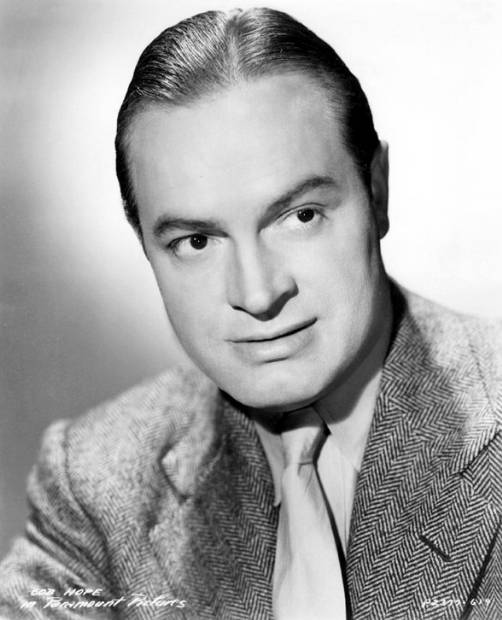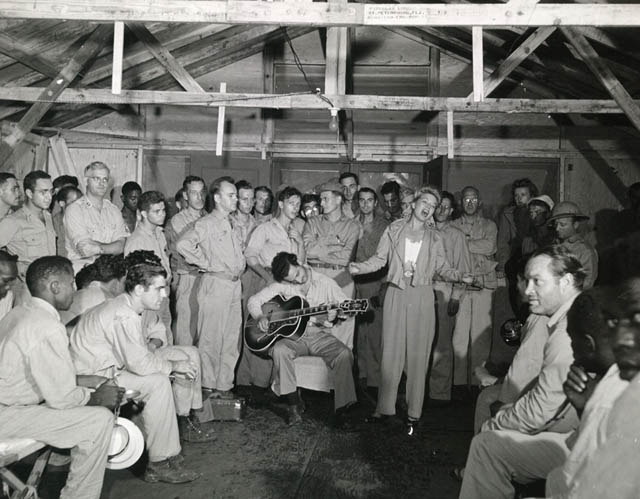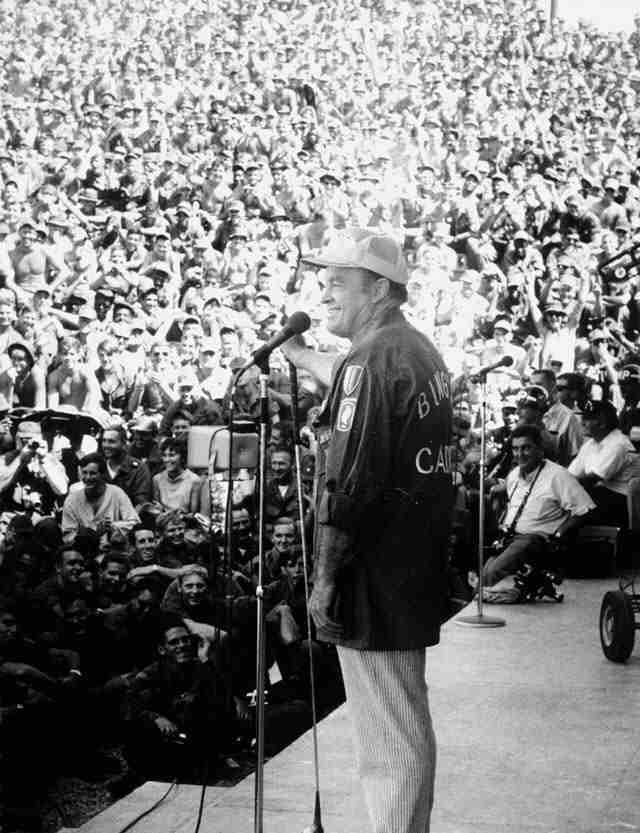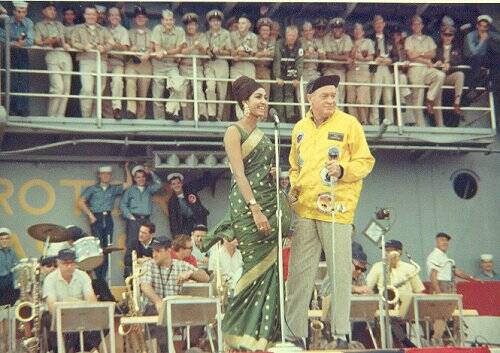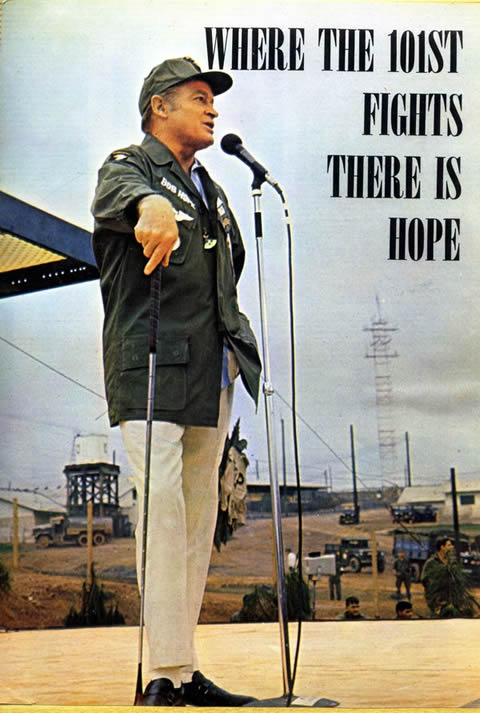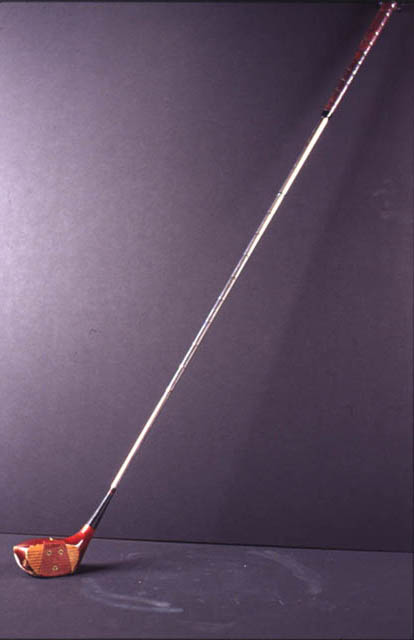GENE SLOVERS
US NAVY PAGES
Bob Hope
First and Only Honorary Veteran
50 Years of Entertaining Our Military Men and Women
This video takes us back 70 years to March Field in early 1941, when Bob Hope and Bing Crosby appeared in what was probably the first organized USO show for our Armed Forces - and only a few months before the beginning of World War II.
In 1996, the U.S. Congress honored Bob Hope by declaring him the "first and only honorary veteran of the U.S. armed forces." Bob Hope appeared in, or hosted 199 known USO shows, and appeared in uncounted numbers of performances for each of those shows.
For a man who played third billing to Siamese twins and trained seals, Bob Hope has become the most recognized profile and talent in the world. And, in the entire history of show business, no individual has traveled so far -- so often -- to entertain so many.
Hope's entertainment persona has been evident in every decade of the 20th century -- from impersonating Charlie Chaplin in front of the firehouse in Cleveland in 1909, to celebrating an unprecedented 60 years with NBC in 1996. The fifth of seven sons, he was born Leslie Townes Hope in Eltham, England on May 29, 1903. His English father, William Henry Hope, was a stonemason -- his Welsh mother, Avis Townes Hope, an aspiring concert singer. In 1907, Leslie's father brought the family to Cleveland, Ohio. In 1920, by virtue of his father's naturalization, 'Bob' -- the name by which the world would later know him -- and his brothers became US citizens. (Bob Jokes, "I left England at the age of four when I found out I couldn't be king.")
10 minute video
Photos and video from National Archives
Prompted by patriotism, and perhaps vaudevillian wanderlust, Bob Hope kept touring for more than fifty years. Returning to his professional roots, he took his variety show on the road to entertain U.S. troops wherever those soldiers were stationed. Hope's variety shows for the troops included comedy monologues, specialty acts, celebrity appearances, dancers, singers, and skits. His mildly irreverent humor, teamed with his variety troupe's beautiful women, provided a welcome respite for the U.S. forces, a reminder, in Hope's words, "of what they were fighting for." The fast pace, broad diversity, and informality of the overseas shows, with acts ranging in tone from brash to sentimental, gave U.S. fighting forces a supportive reminder of home, an essence of American life and values.
World War II Radio Broadcast for Armed Forces During World War IIBob Hope began most of his radio broadcasts with the words, "This is Bob [fill in name of remote location] Hope." Hope continued to entertain U.S. troops, wherever they were stationed, for fifty years. In 1997 Bob Hope was designated an honorary veteran for his humanitarian services to the United States Armed Forces by Congress. He is the only individual in history to have earned this honor. |
|
Bob Hope's first radio show for the U.S. Armed Forces was broadcast from March Field in Riverside, California. During World War II Hope was sufficiently moved by the sacrifices the U.S. troops made on behalf of the U.S. public that he and his radio troupe traveled nearly every week to perform The Pepsodent Show at a military training site. Of the 144 episodes of the radio program aired during the war, only nine originated from NBC's studios. |
|
|
I Never Left HomeIn 1944 Bob Hope wrote a book, I Never Left Home, about his work entertaining members of the armed forces during World War II. Over 1.5 million copies of the book were sold. It was adapted for radio for the Lux Radio Theater and recorded as an album for Capitol Records. |
World War II photos of Bob Hope and CompanyIn the summer of 1944 Bob Hope hopped from island to island in the South Pacific to entertain the troops. It was an emotional, as well as dangerous, journey for Hope and his colleagues. He logged over 30,000 miles and gave more than 150 performances. Accompanying Hope on the trip were guitarist Tony Romano, singer Frances Langford, dancer Patty Thomas, and gag-writer and Hope chum, Barney Dean. |
|
Delivering "Home" for the HolidaysIn December of 1948, Bob Hope and other performers traveled to Berlin, Germany, to entertain members of the armed forces participating in the Berlin Airlift. This was his first Christmas tour to entertain troops and the beginning of a Hope tradition that lasted until1990. Nine of Bob Hope's Christmas tours included Vietnam, from 1964 until 1972. |
|
Da Nang AB: Freedom Hill - 1966
USS Ticonderoga |
|
Bob Hope's Trademark Golf ClubBob Hope never stopped being a vaudevillian. Throughout his 1969 U.S.O. tour he carried on stage a symbol of his life-long love for golf-a golf club-using it as a vaudeville song-and-dance man would use a cane. This is the wood used by Bob Hope on the 1969 World Tour. |
|


